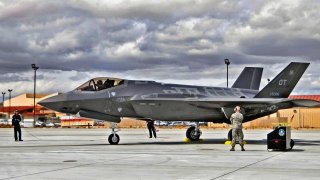The F-35 Fighter Has a New Enemy (Not Russia or China)
The Lockheed Martin F-35 Lightning II, touted for its unmatched capabilities, faces significant cutbacks from U.S. lawmakers. The House Armed Services Committee (HASC) proposed reducing the Pentagon's request for 68 F-35s to 58 in the fiscal 2025 National Defense Authorization Act (NDAA).
Summary: The Lockheed Martin F-35 Lightning II, touted for its unmatched capabilities, faces significant cutbacks from U.S. lawmakers. The House Armed Services Committee (HASC) proposed reducing the Pentagon's request for 68 F-35s to 58 in the fiscal 2025 National Defense Authorization Act (NDAA).

-This reduction stems from ongoing issues with the Technology Refresh 3 (TR-3) software upgrade, which has delayed aircraft deliveries.
-The F-35 program's TR-3 upgrade, crucial for future enhancements, is expected to complete by late summer. The bipartisan frustration highlights the tension between military needs and technological hurdles, potentially limiting the F-35 fleet to just 48 jets next year.
F-35 Lightning II Faces Cutbacks: Lawmakers vs. Lockheed Martin
The Lockheed Martin F-35 Lightning II has been touted as being one of the most capable aircraft in service today. The fifth-generation stealth fighter has capabilities no other combat aircraft can match – yet it might have just met its match, namely U.S. lawmakers.
The House Armed Services Committee (HASC) released its draft version of the fiscal 2025 National Defense Authorization Act (NDAA), and while it proposed adding $1 billion for the Virginia -class submarine program – which would allow the U.S. Navy to begin acquiring a second boat for fiscal year 2025 (FY25) – it also called for slashing ten F-35s from the Department of Defense's (DoD's) request for 68 Lightning IIs.
The Pentagon had sought to purchase forty-two F-35As for the U.S. Air Force, thirteen F-35Bs, and thirteen F-35Cs for the U.S. Navy and U.S. Marine Corps. However, the DoD is currently not accepting deliveries of the F-35 as aircraft maker Lockheed Martin struggles with validating the software for the fighter jet's Technology Refresh 3 (TR-3) upgrade.

The HASC's proposal could first cut the purchase to 58 jets, but it would further not allow the Pentagon to accept delivery of 10 of those fighters until the secretary of defense certifies to lawmakers that the issues with the Lightning II are addressed. As a result, the U.S. military could receive as few as forty-eight F-35s for all of next year.
Bipartisan Frustration With the F-35
The frustration with the TR-3 and other issues has become a rare bipartisan issue, as an undisclosed number of completed or nearly completed F-35s are now sitting at Lockheed Martin's facility in Fort Worth, Texas.
"Over the last couple of years, our members have grown frustrated with the F-35 program," a Republican staffer told Defense News on Monday. "This year, we are struggling with accepting airplanes from Lockheed Martin when they come off the line. So our members wanted to address that because if you have an aircraft come off [the production line and] we're not accepting delivery, what's the point? They're just paperweights at that point."
Lockheed Martin responded to Defense News' request for comment: "We look forward to working with the administration and the Congress as the president's fiscal year 2025 budget receives full consideration in the months ahead."
The TR-3 is More Than a Software Patch
As previously reported, the significance of TR-3 can't be overstated. The upgrade is far more than merely patching software on a computer. It is akin to a full version upgrade and more.
The TR-3 will upgrade nearly the F-35's entire onboard digital infrastructure, improving its data storage and processing capabilities, as well as the user interface. The new software will further enable the stealth fighter jet to carry new air-to-air and air-to-ground weapons, sensors, and cyber countermeasures. It isn't something that can be easily updated later, however, as the upcoming Block 4 upgrade needs the TR-3 software upgrade as a base.

TR-3 is now projected to be completed sometime this summer – but not earlier than July, and possibly as late as September.
Author Experience and Expertise: Peter Suciu
Peter Suciu is a Michigan-based writer. He has contributed to more than four dozen magazines, newspapers, and websites with over 3,200 published pieces over a twenty-year career in journalism. He regularly writes about military hardware, firearms history, cybersecurity, politics, and international affairs. Peter is also a Contributing Writer for Forbes and Clearance Jobs. You can follow him on Twitter: @PeterSuciu. You can email the author: [email protected].


